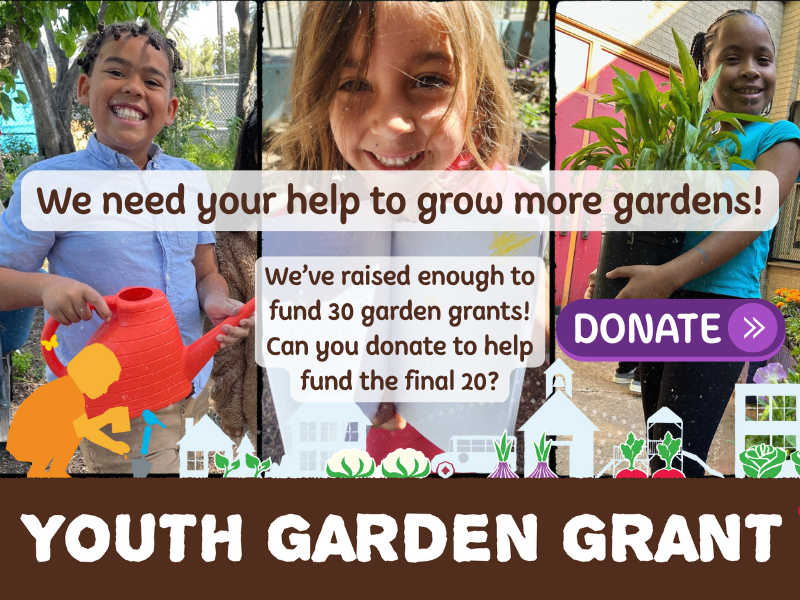When learning is linked to the real world, it's naturally more rewarding. Students who have the opportunity to address genuine community needs see firsthand that their actions can improve the quality of life for others. Education becomes more meaningful and empowering, and their self-esteem flourishes. In addition, as kids become active members of their communities, they also learn what being a socially responsible citizen looks and feels like.
The concept behind this vision — dubbed service learning — goes beyond students simply doing community service.
Service learning explicitly weaves community service with curriculum goals so that learning; personal, social, and civic skills; and communities are strengthened.
These relationships also help schools build bridges to the community and help local people better understand and support educational goals.
Across the country, garden and habitat projects are inspiring students to connect with and serve their communities. They create plantings that reflect a community's diverse cultures, build intergenerational partnerships, involve neighbors in schoolyard planning, teach citizens about recycling waste, share harvests with populations in need, and create urban oases for respite and renewal. And that's just for starters.
Service-Learning Project Ideas
The following are examples of garden-related projects that can help both kids and communities flourish. These examples can also serve as a jumping-off point to investigating what would work best for your community and students:
- Explore local food heritage by interviewing families and community members about culturally relevant plants, foods, gardening methods, and recipes. Create a garden, visitor's guide, and cookbook reflecting the cultural diversity of the community.
- Extend a school pollinator garden project by educating community members how to enhance and protect habitats. Incorporate interpretive signs, a field guide for visitors, and materials describing how citizens can protect and support pollinators and other local wildlife.
- Establish native vegetation on school grounds. Create a video to educate parents, students, residents, news media, and the local government about the importance of native species.
- Write newsletters and articles to make the community aware of waste management issues and teach people about composting. Hold composting demonstrations in the schoolyard.
- Set up a community garden on school grounds and rent plots at reasonable prices to neighbors. Intergenerational friendships and learning take off as students and seniors tend plots and serve as mentors to one another.
Getting Started with Service-Learning
At its core, service-learning involves kids in assessing community needs (or problems), collaborating to propose solutions, and taking action. How you approach this will depend on your unique context, teaching goals, and students' developmental levels. For instance, young students might take on a simple project, such as bringing homegrown flowers to nursing home residents and swapping stories. Older students might tackle an in-depth project aimed at addressing environmental challenges plaguing the community. In either case, here are some factors you should consider.
Planning and Taking Action
Some teachers start by reviewing learning goals (ideally, with students) and then identifying community projects that would meet local needs and support learning. In other cases, students take the lead, identifying a need or problem in the community that sparks their interest and the teacher (or class) examines how to integrate curricular goals with the proposed project.
Before fleshing out a plan, students may need to further assess local needs or problems, research their scope, find out who is addressing the issues, and identify local resources and partnerships to support the process. Consider these questions as you plan and move forward.
- What are my curriculum goals and how can I integrate them with a service-learning project?
- Does the proposed project address a genuine community need?
- How will students gain the content knowledge required to carry out the project?
- How will I organize students to work collaboratively to accomplish tasks and solve problems?
- How will we make the experience meaningful for students and community members?
- How will the project help students learn about their community and its resources?
- How will I ensure that students have a voice in selecting, planning, and carrying out the project?
- How will I make learning goals and tasks clear at each stage?
- How will I assess student gains?
Reflecting on the Process
By providing opportunities for student reflection during the course of a service-learning project (via discussions, writing, presentations, and artistic projects), you enable students to process and apply what they've learned, including:
- Insights about themselves
- New knowledge about their communities
- Challenges of effecting change
- Approaches to problem-solving
- Academic concepts
- When you ask such questions as, What worked well? What can be improved? How can we use what we've learned? and What new questions or "ahas" do we have? you help students think critically and build meaning from their experiences.
Celebrating Success
It's good practice to wrap up a service-learning project by creating opportunities to recognize the contributions and achievements of students and project partners. These might include soliciting media coverage, holding a community event (e.g., community garden dedication), or having a school-wide awards ceremony.
Program Spotlights
Hope Grows -
Follow the Pollinators to Our Garden - Students at Johnsburg High School in Johnsburg, IL, wanted to teach their peers and the community
Native Plant Garden -
St. Clair Superior Development Corporation -
Promise of Peace Gardens -
Indian Run Elementary -
The Bellaire School -
Cheyenne River Youth Project -
Project Climate Club -



